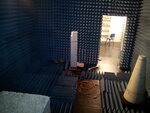mihir08
Member level 4
hi folks, we are testing radiation patterns for different types of antennas in our lab . let me explain you the setup : we have a antenna test kit from signet , basically a tx source at 800 Mhz using folded dipole and at the rx we have a stepper motor turntable on which we fix Rx antenna under test . the problem is that lot of interference occurs and even if some one walks from the test region the readings are affected. please suggest some ways to isolate our test bench . if i use a metallic mesh i think reflections will occur and cant use expensive obsorbers . want to make something effective enough from scratch - wood , foam , aluminum foils  etc .. !!!!
etc .. !!!!
thanks and cheers ,, always good to be on eda
thanks and cheers ,, always good to be on eda
